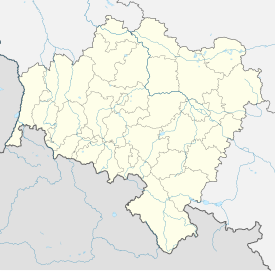
Colditz Castle is a Renaissance castle in the town of Colditz near Leipzig, Dresden and Chemnitz in the state of Saxony in Germany. The castle is between the towns of Hartha and Grimma on a hill spur over the river Zwickauer Mulde, a tributary of the River Elbe. It had the first wildlife park in Germany when, during 1523, the castle park was converted into one of the largest menageries in Europe.

Enna, known from the Middle Ages until 1926 as Castrogiovanni, is a city and comune located roughly at the center of Sicily, southern Italy, in the province of Enna, towering above the surrounding countryside. It has earned the nicknames belvedere and ombelico ("navel") of Sicily.

Blackness Castle is a 15th-century fortress, near the village of Blackness, Scotland, on the south shore of the Firth of Forth.

Tangermünde is a historic town on the Elbe River in the district of Stendal, in the northeastern part of Saxony-Anhalt, Germany. The town has land area of around 89.87 sq.km and a population of 10,283 people as of 2022.
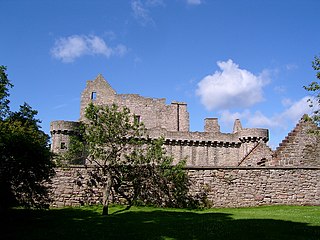
Craigmillar Castle is a ruined medieval castle in Edinburgh, Scotland. It is three miles (4.8 km) south-east of the city centre, on a low hill to the south of the modern suburb of Craigmillar. The Preston family of Craigmillar, the local feudal barons, began building the castle in the late 14th century and building works continued through the 15th and 16th centuries. In 1660, the castle was sold to Sir John Gilmour, Lord President of the Court of Session, who breathed new life into the ageing castle. The Gilmours left Craigmillar in the 18th century for a more modern residence, nearby Inch House, and the castle fell into ruin. It is now in the care of Historic Environment Scotland as a scheduled monument, and is open to the public.
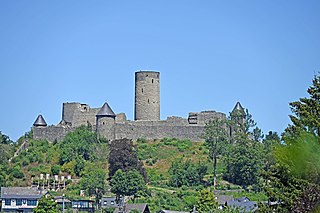
Nürburg is a town in the German district of Ahrweiler, in the state of Rhineland-Palatinate. It is also the name of the local castle, Nürburg Castle, which was built in the High Middle Ages. The castle is made of basalt which usually has black color. The well-known 24-kilometre (15 mi) racing track Nürburgring is nearby.

The Huniade Castle is the oldest monument in Timișoara, Romania, built between 1443 and 1447 by John Hunyadi and Paolo Santini de Duccio over the old royal castle dating from the 14th century. The castle was rebuilt by the Turkish pashas in the 17th century and by Prince Eugene of Savoy in the 18th century. The structure owes its present appearance to the 1850s reconstruction campaign. It houses the History, Archeology and Natural Sciences sections of the National Museum of Banat.

São Jorge Castle, sometimes known in English as Saint George's Castle, is a historic castle in the Portuguese capital of Lisbon, located in the freguesia of Santa Maria Maior. Human occupation of the castle hill dates to at least the 8th century BC while the oldest fortifications on the site date from the 2nd century BC. The hill on which Saint George's Castle stands has played an important part in the history of Lisbon, having served as the location of fortifications occupied successively by Phoenicians, Carthaginians, Romans, and Moors, before its conquest by the Portuguese in the 1147 Siege of Lisbon. Since the 12th century, the castle has variously served as a royal palace, a military barracks, home of the Torre do Tombo National Archive, and now as a national monument and museum.

The Königsberg Castle was one of the landmarks of the city of Königsberg.

The Vilnius Castle Complex is a group of cultural, and historic structures on the left bank of the Neris River, near its confluence with the Vilnia River, in Vilnius, Lithuania. The buildings, which evolved between the 10th and 18th centuries, were one of Lithuania's major defensive structures.

Veveří is an originally ducal and royal castle in Brno in the Czech Republic. It is located about 12 kilometres (7 mi) northwest of Brno city centre on the Svratka River.

Hawthornden Castle is located on the River North Esk in Midlothian, Scotland. The castle lies a mile to the east of Roslin at grid reference NT287637, and is just downstream from Roslin Castle. Hawthornden comprises a 15th-century ruin, with a 17th-century L-plan house attached. The house has been restored and now serves as a writer's retreat. Man-made caves in the rock beneath the castle have been in use for much longer than the castle itself.
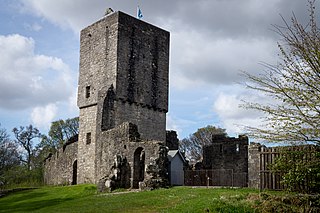
Mugdock Castle was the stronghold of the Clan Graham from the middle of the 13th century. Its ruins are located in Mugdock Country Park, just west of the village of Mugdock in the parish of Strathblane. The castle is within the registration county of Stirlingshire, although it is only 2 kilometres (1.2 mi) north of Milngavie, East Dunbartonshire, on the northern outskirts of Greater Glasgow.

The Palanok Castle or Mukachevo Castle is a historic castle in the city of Mukacheve in the western Ukrainian oblast (province) of Zakarpattia. The Palanok Castle is delicately preserved, and is located on a 68-metre-high (223 ft) former volcanic hill. The castle complex consists of three parts: the high, middle, and low castle.

Ljubljana Castle is a castle complex standing on Castle Hill above downtown Ljubljana, the capital of Slovenia. It is a key landmark of the town. Originally a medieval fortress, it was probably constructed in the 11th century and rebuilt in the 12th century. It acquired its present outline with an almost complete overhaul in the 15th century, whereas the majority of the buildings date to the 16th and 17th centuries. Initially a defense structure and since the first half of the 14th century the seat of the lords of Carniola, it was since the early 19th century used for various other purposes and today is used as a major cultural venue.

Kamianets-Podilskyi Castle is a former Ruthenian-Lithuanian castle and a later three-part Polish fortress located in the historic city of Kamianets-Podilskyi, Ukraine, in the historic region of Podilia in the western part of the country. Its name is attributed to the root word 'kamin', from the Slavic word for 'stone'.
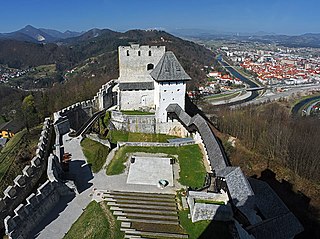
Celje Castle, also known as Celje Upper Castle or Old Castle, is a castle ruin in Celje, Slovenia, formerly the seat of the Counts of Celje. It stands on three hills to the southeast of Celje, where the river Savinja meanders into the Laško valley. Today, the castle is in the process of being restored. It was once the largest fortification on Slovenian territory.

The Castles of Bellinzona are a group of fortifications located around the town of Bellinzona, the capital of the Swiss canton of Ticino. Situated on the Alpine foothills, the group is composed of fortified walls and three castles named Castelgrande, Montebello and Sasso Corbaro. Castelgrande is located on a rocky peak overlooking the valley, with a series of walls that protect the old city and connect to Montebello. Sasso Corbaro, the highest of the three castles, is located on an isolated rocky promontory south-east of the other two. The Castles of Bellinzona with their defensive walls have been an UNESCO World Heritage Site since 2000.
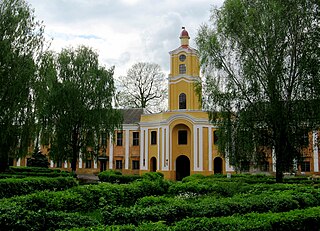
Olyka Castle is a fortified palace in Olyka, Ukraine. Constructed in 1564, it became the principal seat of the Radziwiłł family in Volhynia, once part of the Polish–Lithuanian Commonwealth and now Ukraine. The Radziwiłłs hold the castle for almost four hundred years, since the last owner, Janusz Radziwiłł, owned the castle till 1945. After 1945, it was confiscated and changed into a psychiatric hospital. In 2021, it was transferred to the Volyn museum and is now open for the public.
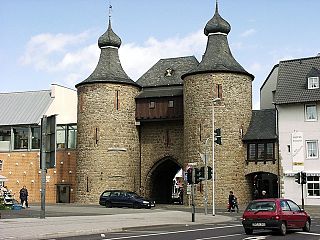
Witch tower or Witches' Tower is a common name or description in English and other European languages for a tower that was part of a medieval town wall or castle, often used as a prison or dungeon.


